Plants around here take immediate advantage of water, so the change in color after less than a week from the first drop of rain is striking.
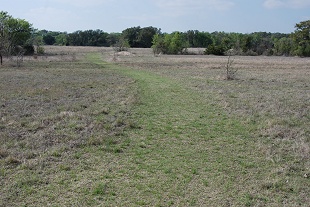
Near Meadow
Not only does green show on the mowed maintenance path, but at the base of the taller clumps to either side. Rain started Wednesday; this was taken Sunday. Last week, no green.
After about two inches had fallen, Richard went out in the continuing rain and said some water was running down from the construction yard (off to the far right of the first image) but not too muddy. We slow and capture some of the construction yard runoff (and grassland runoff) with this gabion, built of rocks we picked up on the land and salvaged old chain-link fence.
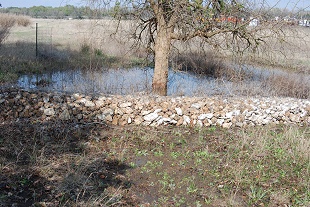
#3 gabion
Intense rain events can produce enough to flow around the ends or even over the top, but usually the water pools up for several days and trickles out slowly, quite clear, across the near meadow. In the distance, you can see part of the construction yard that provides runoff turbid with road base. Much of it settles out behind the gabion, reducing the erosive potential of that water. Water held in the many little pools created by check dams and gabions serves wildlife (and thus our wildlife management goals) but it also improves water quality, slows erosion, and recharges the near-surface groundwater. Notice how green it is where water has actually been for five days, right below the gabion.
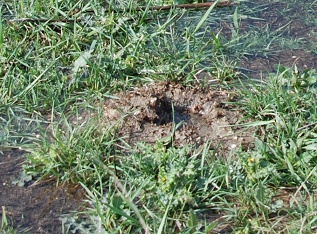
Crawdad hole
Amid the burgeoning annuals, a crawdad that survived the drought comes up to the surface. When I enlarged this shot, I could just see its claws back in the shadows. As soil moisture dropped in the months without rain, I worried about the crawdad population–but this one made it. In the next few days I’ll do a “crawdad chimney” count and see what the population’s looking like. That we have abundant crawdads when there’s water around suggests that the water flowing onto and over the land is not too polluted.
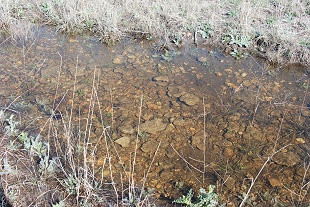
Clear water
This pool, in a natural drainage channel near the highway, receives water from a grass-covered slope, highway runoff, and–via a culvert under the highway–runoff from a rise across the highway (now being cleared for development, which will mean more runoff and more pollution.) For the present, it’s showing what I like to see: clarity, slight coloration consistent with tannin from local vegetation and healthy plants (albeit the grasses are still behind due to drought for past 18-19 months) growing right down to–and in–the water.
This was a rescue rain (too late for some woody plants, alas) and not a recovery or drought-breaker rain. Enough to hold things as they are for perhaps a month, maybe two. If it rained in the same pattern after 3-4 days without, we might be on the verge of water flow in the creek. In lesser droughts it’s taken eight inches in two weeks to restore stream flow (not flood pulse, but flow of clear water) for even a week or two. This time we’re down enough–the soil dry enough–that I estimate it would take ten-twelve (of which we’ve now received four) to produce any spring-flow sufficient to get the water flowing on our place. The headwaters springs of the creek are a few miles north; I doubt they’re doing anything at all, and they certainly aren’t producing enough to push water this far–the land’s soaking up everything it gets.
Years ago in one of my ecology classes our prof said if you manage your water resources properly, everything else will fall into place, and if you don’t manage your water resources, nothing else you do will work. That made sense to me at the time (having been in the ’50s drought in Texas) and still does.
But finally–the first bluebonnet of the season on our place:
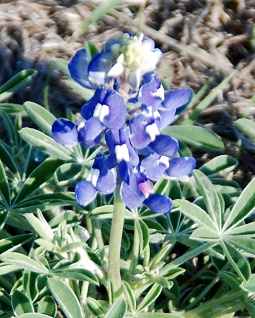
Comment by Chris Gerrib — March 16, 2009 @ 2:07 pm
Cool blog! I’ve been reading these entries on LJ – too lazy so slip on over.
Comment by FrancisT — March 16, 2009 @ 2:33 pm
No ADYF pictures?
Interesting to read about your drought. Here in SE France we had drought up untial a couple of years ago but it was ended last winter (2007/2008) and really definitively ended this winter with far more rain than we really know what to do with. All the clay that dried up and caused building to crack and move has now soaked up so much wet that now all the old cracks are fixed and gates etc. don’t shut because the posts have moved the other way!
During the summer of 2007 we had no rain from early May until October not even a thunderstorm which was quite amazing. Usually there are a few thunderstorms in July and August to provide slight relief and annoy the holidaymakers
Comment by elizabeth — March 16, 2009 @ 4:22 pm
I used to put more up at LJ about the land–in fact, had hoped to use it as my “nature” blog, but ran into so much difficulty putting up the images and then retrieving them that I decided to go elsewhere. Also I wanted to experiment with dedicated blog sites tied to dedicated websites. So now I’m posting more brief “Go take a look at the 80 acres blog” posts with a clue to what’s there.
Drought in Texas is a constant concern–has been for a very long time. We have more years below the average rainfall than above, but the ones above tend to be WAY above. The year before this drought started, we had almost twice the average. It followed two years of low (but not as bad as this one) rainfall. Then the spigot in the sky cut off and there was nothing. The saying here is that the next drought starts the day after the last rain.
Climate change is shifting our months of most rain, which is going to make it very tricky indeed for farmers and ranchers.
Comment by Karen S — March 17, 2009 @ 9:41 am
Bluebonnets! Are the other wildflowers blooming yet?
Comment by elizabeth — March 17, 2009 @ 12:03 pm
Wild onion (the white ones), yellow evening primrose, blue-eyed grass just starting (first yesterday), prairie verbena. No milkweed yet, and the monarchs have already started north–that worries me. The first yellows–tansy ragwort is just starting. Redbuds are still going (some of them); the Mexican plums are over. Don’t know if the thicketing plums will bloom this year or not–sometimes they don’t in a drought, but this was incentive. I expect a burst of flowering in the next week or two, and then if there’s no more rain, everything will die back, to conserve energy.